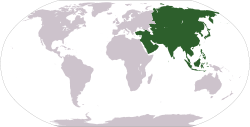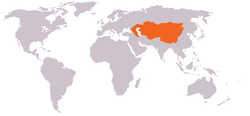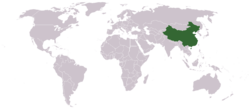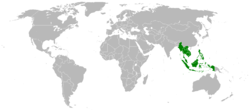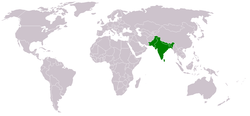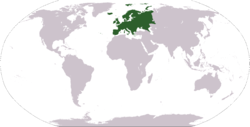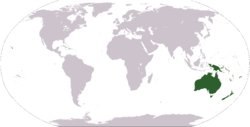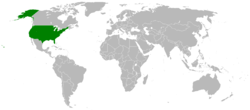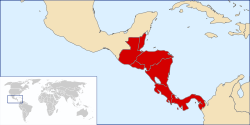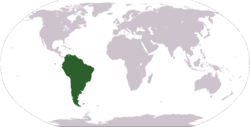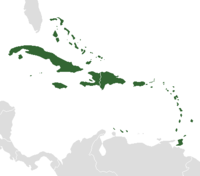- Outline of cuisines
-
Silesian bread buns with caraway seeds

The following outline is provided as an overview of and topical guide to cuisines:
Cuisine – specific set of cooking traditions and practices, often associated with a specific culture. It is often named after the region or place where its underlining culture is present. A cuisine is primarily influenced by the ingredients that are available locally or through trade. Religious food laws can also exercise a strong influence on cuisine.
Contents
Types of cuisine
Main article: CuisineTypes of cuisine
African cuisine
Main article: African cuisineAfrican cuisine reflects indigenous traditions, as well as influences from Arabs, Europeans, and Asians. The continent of Africa is the second largest landmass on the earth and is home to hundreds of tribes, ethnic and social groups. This diversity is also reflected in African cuisine, in the use of basic ingredients as well as in the style of preparation and cooking techniques.[1]
Traditionally, as in almost all cultures, the food of Africa uses a combination of locally available fruits, grains, and vegetables, milk and meat products. In some parts of Africa, the traditional African diet has a predominance of milk, curd, and whey. In much of tropical Africa however, cow's milk is rare and cannot be produced locally (owing to various diseases that affect livestock). Yet, differences, sometimes significant, are noticeable in the eating and drinking habits across the continent of Africa - African food differs in different parts of Africa, and Central Africa, East Africa, the Horn of Africa, North Africa, West Africa and Southern Africa each have their own distinctive foods. They are very well known for their distinctive cooking styles.
- Central African cuisine
- East African cuisine
 Burundian cuisine
Burundian cuisine Kenyan cuisine
Kenyan cuisine Tanzanian cuisine
Tanzanian cuisine Ugandan cuisine
Ugandan cuisine
- Horn African cuisine
 Eritrean cuisine
Eritrean cuisine Ethiopian cuisine
Ethiopian cuisine Somali cuisine
Somali cuisine
- North African cuisine
- Southern African cuisine
 Botswanan cuisine
Botswanan cuisine Malagasy cuisine
Malagasy cuisine Mauritian cuisine
Mauritian cuisine Namibian cuisine
Namibian cuisine South African cuisine
South African cuisine Zimbabwean cuisine
Zimbabwean cuisine
- West African cuisine
Asian cuisine
Main article: Asian cuisineAsian cuisine styles can be broken down into several regional styles that have roots in the peoples and cultures of those regions. The major types can be roughly defined as East Asian with its origins in Imperial China and now encompassing modern Japan and the Korean peninsula; Southeast Asian which encompasses the areas once found in the Khmer Empire including Cambodia, Laos, Thailand and Viet Nam as well as the countries of Brunei, Indonesia, Malaysia, Philippines, and Singapore; South Asian derived the states that once made up British India – Burma, India, Sri Lanka and Pakistan as well as several other countries in this region of the continent;[2] Central Asian and Middle Eastern.
Ingredients common to many cultures in the east and southeast regions of the continent include rice, ginger, garlic, sesame seeds, chilies, dried onions, soy, and tofu. Additionally, cooking methods such as stir frying, steaming and deep frying are also common across many of these cuisine styles. While rice is common to most Asian cuisines, different varieties are popular in the various regions; Basmati rice is popular in the subcontinent, Jasmine is often found across the southeast, while long-grain rice is popular in China and short-grain in Japan and Korea.[3] Curry is also a common dish in found in southern and eastern Asia, however they are not as popular in eastern cuisines. Those curry dishes with origins in India and other South Asian countries usually have a yogurt base while southeastern and eastern curries are generally use coconut milk as their foundation.[4]
Central Asian cuisine
 Afghan cuisine
Afghan cuisine Kazakh cuisine
Kazakh cuisine Kyrgyz cuisine
Kyrgyz cuisine Mongolian cuisine
Mongolian cuisine Tajik cuisine
Tajik cuisine Tibetan cuisine
Tibetan cuisine Turkmen cuisine
Turkmen cuisine Uyghur cuisine (Cuisine of Xinjiang)
Uyghur cuisine (Cuisine of Xinjiang) Uzbek cuisine
Uzbek cuisine
East Asian cuisine
The styles of cuisine found in traditional East Asian cuisines evolved with a common usage of oils, fats and sauces in the preparation of dishes. China, with its long history, massive population and widely distributed diaspora, has become possibly the most well known of the cuisines originating from this region of the world. The cuisine found in China has its origins in what is known as the Eight Great Traditions, however its cuisine can be generalized into northern styles that feature oils and strong flavors derived from ingredients such as vinegar and garlic while southern styles tend to favor fresh ingredients that are lightly prepared. Japanese cuisine has become known for dishes such as sushi that focus on raw ingredients and deep fried dishes such as tempura. Korean cuisine has come to feature cooking methods such as sauteing and what is known in the West as barbecue. Strong flavors featuring spices derived from chili peppers can also be found in dishes such as kimchi.[2]
Chinese cuisine
Main article: Chinese cuisineChinese cuisine (Traditional Chinese: 中國菜, Simplified Chinese: 中国菜, Pinyin: Zhōngguócài) originated from the various regions of China and has become widespread in many other parts of the world — from Asia to the Americas, Australia, Western Europe and Southern Africa. In recent years, connoisseurs of Chinese cuisine have also sprouted in Eastern Europe and South Asia. American Chinese cuisine and Canadian Chinese food are popular examples of local varieties. Local ingredients would be adopted while maintaining the style and preparation technique.
Regional cultural differences vary greatly amongst the different regions of China, giving rise to the different styles of food. There are eight main regional cuisines, or Eight Great Traditions (八大菜系, Bā Dà Cài Xì): Anhui, Cantonese, Fujian, Hunan, Jiangsu, Shandong, Sichuan, and Zhejiang. Among them, Cantonese, Sichuan, Shandong, and Huaiyang cuisine (a major style and even viewed as the representation of the entire Jiangsu cuisine) are often considered as the standouts of Chinese cuisine and due to their influence are proclaimed as the Four Great Traditions (四大菜系, Sì Dà Cài Xì). There are also featured Buddhist and Muslim sub-cuisines within the greater Chinese cuisine, with an emphasis on vegetarian and halal-based diets respectively.
- Beijing cuisine
- Chinese Buddhist cuisine
- Cantonese cuisine
- Chiuchow cuisine
- Hakka cuisine
- Henan cuisine
- Anhui cuisine
- Fujian cuisine
- Hubei cuisine
- Hunan cuisine
- Chinese Islamic cuisine
- Shanxi cuisine
- Jiangxi cuisine
- Shanghai cuisine
- Tibetan cuisine
- Jiangsu cuisine
- Guizhou cuisine
- Northeastern Chinese cuisine
- Shandong cuisine
- Shaanxi cuisine
- Szechuan cuisine (Sichuan)
- Yunnan cuisine
- Zhejiang cuisine
- Xinjiang cuisine
Southeast Asian cuisine
The styles of cuisine found in the Southeast Asian regions include a strong emphasis lightly prepared dishes with a strong aromatic component that features such flavors as citrus and herbs such as mint, cilantro (coriander) and basil. Ingredients in the region contrast with the ones in the Eastern Asian cuisines, substituting fish sauces for soy sauce and the inclusion of ingredients such as galangal, tamarind and lemon grass. Cooking methods include a balance of stir-frying, boiling and steaming.[2]
As these cultures grew outwards from their homelands, their cuisines were influenced by the styles and methods of both western and northern Asia. West Asian influence can be seen in the curry dishes and Indian spices, such as cardamom and cumin, that are found in cuisines throughout the southern countries; while Chinese influences, including traditional spices like coriander and star anise, can be tasted most noticeably in Vietnamese cuisine. As European nations colonized the region, the influences of French, British and Dutch cuisine further altered the culinary landscape. One of the more widely known ingredients westerners brought to Asia was the chili pepper, originally from the Americas.[5]
 Cambodian cuisine
Cambodian cuisine Indonesian cuisine
Indonesian cuisine
 Laotian cuisine
Laotian cuisine Malaysian cuisine
Malaysian cuisine
 Burmese cuisine
Burmese cuisine Filipino cuisine
Filipino cuisine Singaporean cuisine
Singaporean cuisine Thai cuisine
Thai cuisine Vietnamese cuisine
Vietnamese cuisine
South Asian cuisine
Main article: South Asian cuisineThe cuisine of South Asia has roots in several regions and cultures, including Persia, Turkey, and the Middle East as well practices taken from the Hindu beliefs practiced by the large population found in the region. Naan, a type of flat bread from the former regions is a common part of meals to be had in many parts of South Asia. Foods in this area of the world are known for their use of hot peppers, black pepper, cloves, and other strong spices along with the flavored butter ghee. Common meats include lamb, goat and chicken; beef is not very common as western cuisines because of the tenets of the Hindu faith prohibit its consumption. Other staples of many of the cuisines include rice, chapati made from wheat and barley, and beans.[2]
 Bangladeshi cuisine
Bangladeshi cuisine Bhutanese cuisine
Bhutanese cuisine Maldivian cuisine
Maldivian cuisine Nepalese cuisine
Nepalese cuisine Pakistani cuisine
Pakistani cuisine Sri Lankan cuisine
Sri Lankan cuisine
Indian cuisine
Main article: Indian cuisine250pxIndian cuisine is characterized by its sophisticated and subtle use of many spices and vegetables grown across India and also for the widespread practice of vegetarianism across its society. Considered by some to be one of the world's most diverse cuisines, each family of this cuisine is characterized by a wide assortment of dishes and cooking techniques. As a consequence, Indian cuisine varies from region to region, reflecting the varied demographics of the ethnically diverse Indian subcontinent.[6]
India's religious beliefs and culture has played an influential role in the evolution of its cuisine. However, cuisine across India also evolved with the subcontinent's cross-cultural interactions with the neighboring Middle East and Central Asia as well as the Mediterranean, making it a unique blend of various cuisines across Asia.[7][8] The colonial period introduced European cooking styles to India adding to its flexibility and diversity.[9][10] Indian cuisine has also influenced cuisines across the world, especially those from Southeast Asia.[11][12][13] In particular, curry has been widely adopted in cuisines around the world.
- Punjabi cuisine
- Cuisine of Uttar Pradesh
- Rajasthani cuisine
- Mughlai cuisine
- Bhojpuri cuisine
- Bihari cuisine
- Kashmiri cuisine
- Kerala cuisine
- Tamil cuisine
- Andhra cuisine
- Cuisine of Karnataka
- Hyderabadi cuisine
- East Indian cuisines
- North-East Indian cuisines
- West Indian cuisines
- Goan cuisine
- Gujarati cuisine
- Maharashtrian cuisine
- Malvani cuisine
- Parsi cuisine
- Rajasthani cuisine
- Other
- Indian Chinese cuisine
- Jain (Satvika)
- Sindhi cuisine
- Chettinad cuisine
- Udupi cuisine
- Indian fast food
West Asian cuisine
- Middle Eastern cuisine – various cuisines of the Middle East. Despite their similarities, there are considerable differences in climate and culture, so the term is not definitive.
- Arab cuisine – various regional cuisines spanning the Arab World from Iraq to Morocco to Somalia to Yemen, and incorporating Levantine, Egyptian and others. It has also been influenced to a degree by the cuisines of Turkey, Pakistan, Iran, India, the Berbers and other cultures of the peoples of the region before the cultural Arabization brought by genealogical Arabians during the Arabian Muslim conquests.
- Levantine cuisine – traditional cuisine of Ottoman Syria, now usually called the Levant. This region shared many culinary traditions under the Ottoman Empire which continue to be influential today. It covers the modern states of Syria, Lebanon, Jordan, Palestine, Israel, northwest Iraq (the province of Mosul), and southern Turkey near Adana, Gaziantep, and Mardin.
 Israeli cuisine
Israeli cuisine Jordanian cuisine
Jordanian cuisine Lebanese cuisine
Lebanese cuisine Palestinian cuisine
Palestinian cuisine Syrian cuisine
Syrian cuisine
European cuisine
European cuisine, or alternatively Western cuisine is a generalized term collectively referring to the cuisines of Europe and other Western countries. European cuisine includes that of Europe and to some extent Russia, as well as non-indigenous cuisines of North America, Australasia, Oceania, and Latin America. The term is used by East Asians to contrast with Asian styles of cooking.[14] This is analogous to Westerners referring collectively to the cuisines of Asian countries as Asian cuisine. When used by Westerners, the term may refer more specifically to cuisine in Europe; in this context, a synonym is Continental cuisine, especially in British English.
Northern European cuisine
- British Isles
- Scandinavia
 Danish cuisine
Danish cuisine
 Faroese cuisine
Faroese cuisine Greenlandic cuisine
Greenlandic cuisine
 Finnish cuisine
Finnish cuisine Icelandic cuisine
Icelandic cuisine Lappish cuisine
Lappish cuisine Norwegian cuisine
Norwegian cuisine Swedish cuisine
Swedish cuisine
Western European cuisine
Eastern European cuisine
Caucasian cuisine
 Belarusian cuisine
Belarusian cuisine Czech cuisine
Czech cuisine Hungarian cuisine
Hungarian cuisine Moldovan cuisine
Moldovan cuisine Polish cuisine
Polish cuisine Romanian cuisine
Romanian cuisine Russian cuisine
Russian cuisine
 Slovak cuisine
Slovak cuisine Slovenian cuisine
Slovenian cuisine Ukrainian cuisine
Ukrainian cuisine
- The Caucasus
Southern European cuisine
|;Balkans
 Albanian cuisine
Albanian cuisine Bosnian cuisine
Bosnian cuisine Bulgarian cuisine
Bulgarian cuisine Croatian cuisine
Croatian cuisine Greek cuisine
Greek cuisine
 Macedonian cuisine
Macedonian cuisine Montenegrin cuisine
Montenegrin cuisine Serbian cuisine
Serbian cuisine Turkish cuisine
Turkish cuisine
- Italian Peninsula
- Iberian Peninsula
Spanish cuisine
Main article: Spanish cuisineSpanish cuisine – variety of dishes including thousands of recipes and flavors arising from Spain's extensive history with many cultural influences, and variations in geography and climate. It is heavily influenced by seafood available from the waters that surround the country, and reflects the country's deep maritime roots.
 Andalusian cuisine
Andalusian cuisine Asturian cuisine
Asturian cuisine Aragonese cuisine
Aragonese cuisine Balearic cuisine
Balearic cuisine Basque cuisine
Basque cuisine Canarian cuisine
Canarian cuisine
 Cantabrian cuisine
Cantabrian cuisine Castilian-Manchego cuisine
Castilian-Manchego cuisine Catalan cuisine
Catalan cuisine Galician cuisine
Galician cuisine Leonese cuisine
Leonese cuisine Valencian cuisine
Valencian cuisine
Cuisine of Oceania
 Australian cuisine
Australian cuisine Cuisine of Mariana Islands
Cuisine of Mariana Islands New Zealand cuisine
New Zealand cuisine Palauan cuisine
Palauan cuisine Samoan cuisine
Samoan cuisine Tongan cuisine
Tongan cuisine
Cuisines of the Americas
Cuisines of the Americas are based on the cuisines of the countries from which the immigrant peoples came, primarily Europe. However, the traditional European cuisine has been adapted to a greater or lesser degree and many local ingredients and techniques have been added to the tradition.
North American cuisine
Main article: North American cuisineCuisine of the United States
Main article: American cuisineThe cuisine of the United States is a style of food preparation derived from the United States. The cuisine has a history dating back before the colonial period when the Native Americans had a rich and diverse cooking style for an equally diverse amount of ingredients. With European colonization, the style of cookery changed vastly, with numerous ingredients introduced from Europe, as well as cooking styles and modern cookbooks. The style of cookery continued to expand into the 19th and 20th centuries with the influx of immigrants from various nations across the world. This influx has created a rich diversity and a unique regional character throughout the country. In addition to cookery, cheese and wine play an important role in the cuisine. The wine industry is regulated by American Viticultural Areas (AVA) (regulated appellation), similar to those laws found in countries such as France and Italy.
- Northeastern cuisines
- Cajun cuisine
 Floribbean cuisine
Floribbean cuisine Louisiana Creole cuisine
Louisiana Creole cuisine Lowcountry cuisine
Lowcountry cuisine Cuisine of Kentucky
Cuisine of Kentucky
 California cuisine
California cuisine Cuisine of California
Cuisine of California Hawaiian cuisine
Hawaiian cuisine- Pacific Northwest cuisine
- Chinese American cuisine
- Euro-Asian cuisine
- Italian-American cuisine
- New American cuisine
- Other
Central American cuisine
Main article: Latin American cuisineLatin American cuisine incorporates influences from all over the world. Most came due to colonization and the resulting mixtures among the Native Americans, European immigrants, and African slaves. Different waves of immigration (Some resulting from wars, such as World War II) have also had a hand in this mixture, mainly in the form of immigrants from central and eastern Europe and from east Asia (mainly China and Japan).
 Belizean cuisine
Belizean cuisine Costa Rican cuisine
Costa Rican cuisine Salvadoran cuisine
Salvadoran cuisine Guatemalan cuisine
Guatemalan cuisine Honduran cuisine
Honduran cuisine Nicaraguan cuisine
Nicaraguan cuisine Panamanian cuisine
Panamanian cuisine
South American cuisine
Main article: South American cuisineSome of the richest food products of South America come from the middle of the continent, the Amazonia. In countries like Peru there is a strong influence of the Inca and their cuisine. Potatoes are frequently grown as a result of this, and also plants such as quinoa. On the Southern tip of South America lies the Pacific Ocean, which provides a large array of seafood. Many plains also are on this continent, which are rich for growing food in abundance. In the Patagonia south of Chile and Argentina, many people produce lamb and venison. King crab is typically caught at the southern end of the continent. Antarctic krill has just recently been discovered and is now considered a fine dish. Tuna and tropical fish are caught all around the continent, but Easter Island is one place where they are found in abundance. Lobster is also caught in great quantities from Juan Fernández. In Brazil the most traditional dish is the feijoada.
 Argentinian cuisine
Argentinian cuisine Brazilian cuisine
Brazilian cuisine Chilean cuisine
Chilean cuisine Colombian cuisine
Colombian cuisine Ecuadoran cuisine
Ecuadoran cuisine Peruvian cuisine
Peruvian cuisine
- Peruvian-Chinese cuisine (chifa)
 Uruguayan cuisine
Uruguayan cuisine Venezuelan cuisine
Venezuelan cuisine
Caribbean cuisine
Main article: Caribbean cuisineCaribbean cuisine is a fusion of West African, Amerindian, British, Spanish, French, Dutch and Indian cuisines. These traditions were brought from the many homelands of this region's population. In addition, the population has created from this vast wealth of tradition many styles that are unique to the region. Seafood is one of the most common cuisine types in the islands, though this is certainly due in part to their location. Each island will likely have its own specialty. Some prepare lobster or conch, while others prefer certain types of fish or sharks.
 Cuisine of Antigua and Barbuda
Cuisine of Antigua and Barbuda Cuban cuisine
Cuban cuisine Cuisine of Curaçao
Cuisine of Curaçao Dominican cuisine
Dominican cuisine Dominican Republic cuisine
Dominican Republic cuisine Grenadian cuisine
Grenadian cuisine Guyanese cuisine
Guyanese cuisine Haitian cuisine
Haitian cuisine Jamaican cuisine
Jamaican cuisine Martinican cuisine
Martinican cuisine Puerto Rican cuisine
Puerto Rican cuisine Cuisine of Saint Kitts and Nevis
Cuisine of Saint Kitts and Nevis Trinidad and Tobago cuisine
Trinidad and Tobago cuisine
Ethnic and religious cuisines
- Ainu cuisine
- Arab cuisine
- Berber cuisine
- Buddhist cuisine
- Chinese Islamic cuisine
- Jewish cuisine
- Native American cuisine
- Parsi cuisine
- Pennsylvania Dutch cuisine
- Peranakan cuisine
Cuisine styles
History of cuisine
- Main article: History of cuisine
Historical cuisines
- Africa
- Americas
- Native American cuisine
- Andean cuisine
- Aztec cuisine
- Maya cuisine
- Inca cuisine
- Cuisine of the Thirteen Colonies
- Asia
- Ancient Israelite cuisine
- Byzantine cuisine
- History of Chinese cuisine
- History of Indian cuisine
- Ottoman cuisine
- Europe
- Ancient Greek cuisine
- Ancient Roman cuisine
- Medieval cuisine
- Early modern European cuisine
- Soviet cuisine
See also
- Global cuisines
- Regional cuisine
- Bistronomy
- Casual dining
- Comfort food
- Eating
- Fast food
- Fine dining
- Raw food diet
- Western pattern diet
- Beers of the world
- List of wine-producing countries
- National dish
References
- ^ Bea Sandler (1993). The African Cookbook. Diane and Leo Dillon (Illust.). Carol Publishing Group. ISBN 0806513985. http://www.africa.upenn.edu/Cookbook/about_cb_wh.html. Retrieved 2008-12-18.
- ^ a b c d Le, C.N. (2008). "Asian Cuisine & Foods.". Asian-Nation: The Landscape of Asian America. http://www.asian-nation.org/asian-food.shtml. Retrieved 2008-12-18.
- ^ "The flavors of Asia". Quaker Oats Company. http://www.ricearoni.com/rar_flavorsOfTheWorld/asian/. Retrieved 2008-12-19.[dead link]
- ^ "Cuisine Areas Of Asia". Kraft Foods (Australia. 2007. http://www.kraft.com.au/CookingSchool/CookingBasics/AsianCuisine/CuisineAreasOfAsia/. Retrieved 2008-12-20.
- ^ "The South East - Thailand, Laos, Cambodia, Vietnam, Indonesia, Malaysia, Singapore, Brunei". Kraft Foods (Australia. 2007. http://www.kraft.com.au/CookingSchool/CookingBasics/AsianCuisine/CuisineAreasOfAsia/TheSouthEast.htm. Retrieved 2008-12-20.
- ^ "www.indiaat60.in/backgrounders/Incredible-India@60-indian-cuisine.pdf" (PDF). http://www.indiaat60.in/backgrounders/Incredible-India@60-indian-cuisine.pdf.
- ^ Chandra, Sanjeev (2008-02-07). "www.thestar.com/article/300969". The Star (Toronto). http://www.thestar.com/article/300969. Retrieved 2010-05-08.
- ^ "www.indianfoodsco.com/Classes/CulinayHistory.htm". http://www.indianfoodsco.com/Classes/CulinayHistory.htm.
- ^ "www.mit.edu:8001/people/alycem/writing_indiancooking.html". http://www.mit.edu:8001/people/alycem/writing_indiancooking.html.
- ^ "www.inmamaskitchen.com/Indian_Cooking/history_Indian_food_cooking.html". http://www.inmamaskitchen.com/Indian_Cooking/history_Indian_food_cooking.html.
- ^ "www.vegvoyages.com/food.htm". http://www.vegvoyages.com/food.htm.
- ^ "www.asiafood.org/features_dietary_culture4.cfm". http://www.asiafood.org/features_dietary_culture4.cfm.
- ^ "www.cafemeetingplace.com/pdf/lesson_dec07.pdf" (PDF). http://www.cafemeetingplace.com/pdf/lesson_dec07.pdf.
- ^ Leung Man-tao (12 February 2007), "Eating and Cultural Stereotypes", Eat and Travel Weekly, no. 312, p. 76. Hong Kong
External links
- eNotes - Encyclopedia of Food and Culture
- The Global Gastronomer - Cuisines of the World
- Wikia - Recipes Wiki
Outlines - General reference
- Culture and the arts
- Geography and places
- Health and fitness
- History and events
- Mathematics and logic
- Natural and physical sciences
- People and self
- Philosophy and thinking
- Religion and belief systems
- Society and social sciences
- Technology and applied sciences
African cuisine National cuisines - Algeria
- Angola
- Benin
- Botswana
- Burkina Faso
- Burundi
- Cameroon
- Cape Verde
- Centrafrican (Central African Republic)
- Chad
- Comoros
- The Republic of the Congo
- The Democratic Republic of the Congo
- Egypt
- Eritrea
- Ethiopia
- Gabon
- Ghana
- Ivorian (Côte d'Ivoire)
- Kenya
- Libya
- Madagascar
- Morocco
- Mozambique
- Namibia
- Nigerien (Niger)
- Nigerian
- Rwanda
- Senegal
- Sierra Leone
- Somalia
- South Africa
- Sudan
- Swaziland
- Tanzania
- Tunisia
- Uganda
- Zambia
- Zimbabwe
Ethnic and regional cuisines American cuisine Historical Regional Allentown, Pennsylvania · California · Cincinnati · Kentucky · Hawaii · Midwestern · Chicago · New England · New Mexico · New York City · Omaha · Pacific Northwest · Philadelphia · Puerto Rico · Southern · Cajun · Creole · Lowcountry · Barbecue in Texas · Tex-Mex · Floribbean · Southwest · Western
Ethnic American Chinese · Soul food · Native American · Pennsylvania Dutch · Italian American · Tlingit
Miscellanea Asian cuisine Sovereign
states- Afghanistan
- Armenia
- Azerbaijan
- Bahrain
- Bangladesh
- Bhutan
- Brunei
- Burma (Myanmar)
- Cambodia
- People's Republic of China
- Cyprus
- East Timor (Timor-Leste)
- Egypt
- Georgia
- India
- Indonesia
- Iran
- Iraq
- Israel
- Japan
- Jordan
- Kazakhstan
- North Korea
- South Korea
- Kuwait
- Kyrgyzstan
- Laos
- Lebanon
- Malaysia
- Maldives
- Mongolia
- Nepal
- Oman
- Pakistan
- Philippines
- Qatar
- Russia
- Saudi Arabia
- Singapore
- Sri Lanka
- Syria
- Tajikistan
- Thailand
- Turkey
- Turkmenistan
- United Arab Emirates
- Uzbekistan
- Vietnam
- Yemen
States with limited
recognition- Abkhazia
- Nagorno-Karabakh
- Northern Cyprus
- Palestine
- Republic of China (Taiwan)
- South Ossetia
Dependencies and
other territoriesEuropean cuisine Sovereign
states- Albania
- Andorra
- Armenia
- Austria
- Azerbaijan
- Belarus
- Belgium
- Bosnia and Herzegovina
- Bulgaria
- Croatia
- Cyprus
- Czech Republic
- Denmark
- Estonia
- Finland
- France
- Georgia
- Germany
- Greece
- Hungary
- Iceland
- Ireland
- Italy
- Kazakhstan
- Latvia
- Liechtenstein
- Lithuania
- Luxembourg
- Macedonia
- Malta
- Moldova
- Monaco
- Montenegro
- Netherlands
- Norway
- Poland
- Portugal
- Romania
- Russia
- San Marino
- Serbia
- Slovakia
- Slovenia
- Spain
- Sweden
- Switzerland
- Turkey
- Ukraine
- United Kingdom
- (England
- Northern Ireland
- Scotland
- Wales)
- Vatican City
States with limited
recognition- Abkhazia
- Kosovo
- Nagorno-Karabakh Republic
- Northern Cyprus
- South Ossetia
- Transnistria
Dependencies
and other territories- Åland
- Faroe Islands
- Gibraltar
- Guernsey
- Jan Mayen
- Jersey
- Isle of Man
- Svalbard
Cuisine of the Mediterranean Northern Africa Southern Europe European regions Western Asia Middle Eastern cuisine North American cuisine Sovereign states - Antigua and Barbuda
- Bahamas
- Barbados
- Belize
- Canada
- Costa Rica
- Cuba
- Dominica
- Dominican Republic
- El Salvador
- Grenada
- Guatemala
- Haiti
- Honduras
- Jamaica
- Mexico
- Nicaragua
- Panama
- Saint Kitts and Nevis
- Saint Lucia
- Saint Vincent and the Grenadines
- Trinidad and Tobago
- United States

Dependencies and
other territories- Anguilla
- Aruba
- Bermuda
- Bonaire
- British Virgin Islands
- Cayman Islands
- Curaçao
- Greenland
- Guadeloupe
- Martinique
- Montserrat
- Puerto Rico
- Saint Barthélemy
- Saint Martin
- Saint Pierre and Miquelon
- Saba
- Sint Eustatius
- Sint Maarten
- Turks and Caicos Islands
- United States Virgin Islands
South American cuisine Sovereign states Dependencies and
other territories- Aruba
- Bonaire
- Curaçao
- Falkland Islands
- French Guiana
- Latin American cuisine
North America - Mexico

Central America - Belize · Costa Rica
- El Salvador
- Guatemala
- Honduras
- Nicaragua
- Panama
Caribbean - Antigua and Barbuda
- Bahamas
- Barbados
- Cuba
- Dominica
- Dominican Republic
- Grenada
- Haiti
- Jamaica
- Puerto Rico1
- St. Kitts and Nevis
- St. Lucia
- St. Vincent and the Grenadines
- Trinidad and Tobago
South America - Dependencies not included.
- 1 Defined as a semi-autonomous territory.
Wine by country Albania · Algeria · Argentina · Armenia · Australia · Austria · Azerbaijan · Belgium · Brazil · Bulgaria · Canada · Chile · China · Croatia · Cyprus · Czech Republic · Denmark · Egypt · France · Germany · Georgia · Greece · Hungary · India · Iran · Israel · Italy · Japan · Kazakhstan · Lebanon · Liechtenstein · Luxembourg · Macedonia · Malta · Mexico · Moldova · Montenegro · Morocco · Namibia · Netherlands · New Zealand · Portugal · Romania · Russia · San Marino · Serbia · Slovakia · Slovenia · South Africa · Spain · Sweden · Switzerland · Turkey · Ukraine · United Kingdom · United States · Uruguay · Vietnam Categories:
Categories:- Outlines
- Cuisine
- Food-related lists
Wikimedia Foundation. 2010.



